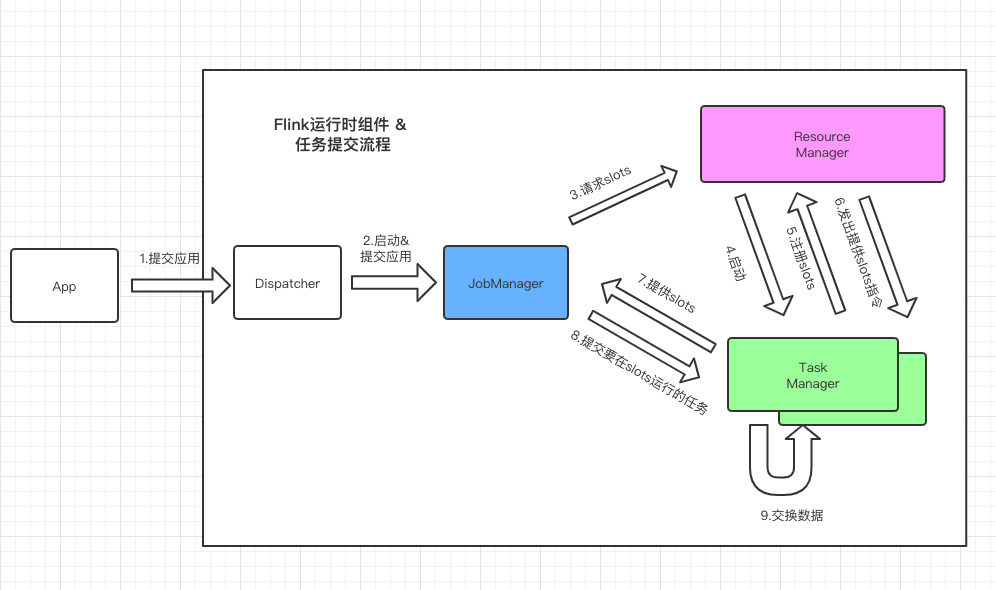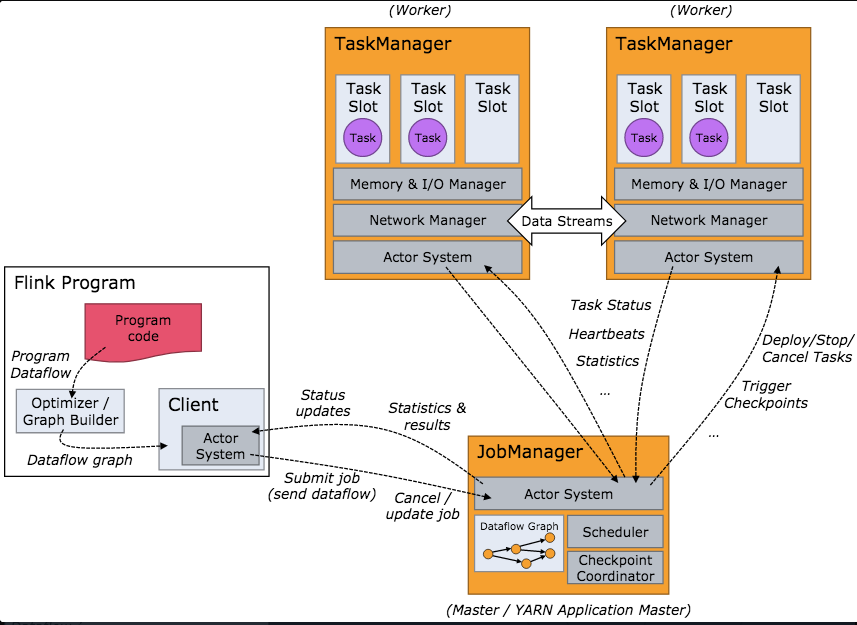Flink(三) —— 运行架构
Flink运行时组件
- JobManager 作业管理器
- TaskManager 任务管理器
- ResourceManager 资源管理器
- Dispatcher 分发器
任务提交流程

任务调度原理
Job Managers, Task Managers, Clients
The Flink runtime consists of two types of processes:
The JobManagers (also called masters) coordinate the distributed execution. They schedule tasks, coordinate checkpoints, coordinate recovery on failures, etc.
There is always at least one Job Manager. A high-availability setup will have multiple JobManagers, one of which one is always the leader, and the others are standby.
The TaskManagers (also called workers) execute the tasks (or more specifically, the subtasks) of a dataflow, and buffer and exchange the data streams.
There must always be at least one TaskManager.
The JobManagers and TaskManagers can be started in various ways: directly on the machines as a standalone cluster, in containers, or managed by resource frameworks like YARN or Mesos. TaskManagers connect to JobManagers, announcing themselves as available, and are assigned work.
The client is not part of the runtime and program execution, but is used to prepare and send a dataflow to the JobManager. After that, the client can disconnect, or stay connected to receive progress reports. The client runs either as part of the Java/Scala program that triggers the execution, or in the command line process ./bin/flink run ....

Task Slots and Resources
Each worker (TaskManager) is a JVM process, and may execute one or more subtasks in separate threads. To control how many tasks a worker accepts, a worker has so called task slots (at least one).
每个TaskManager都是一个JVM进程,可以在独立的线程中执行一个或多个子任务。TaskManager有Task Slots来控制可以接收多少个任务(一个TaskManager至少有一个Task Slot)。
Each task slot represents a fixed subset of resources of the TaskManager. A TaskManager with three slots, for example, will dedicate 1/3 of its managed memory to each slot. Slotting the resources means that a subtask will not compete with subtasks from other jobs for managed memory, but instead has a certain amount of reserved managed memory. Note that no CPU isolation happens here; currently slots only separate the managed memory of tasks.
By adjusting the number of task slots, users can define how subtasks are isolated from each other. Having one slot per TaskManager means each task group runs in a separate JVM (which can be started in a separate container, for example). Having multiple slots means more subtasks share the same JVM. Tasks in the same JVM share TCP connections (via multiplexing) and heartbeat messages. They may also share data sets and data structures, thus reducing the per-task overhead.

参考文档
Flink Distributed Runtime Environment
Flink(三) —— 运行架构的更多相关文章
- Flink 的运行架构详细剖析
1. Flink 程序结构 Flink 程序的基本构建块是流和转换(请注意,Flink 的 DataSet API 中使用的 DataSet 也是内部流 ).从概念上讲,流是(可能永无止境的)数据记录 ...
- Flink| 运行架构
1. Flink运行时组件 作业管理器(JobManager) 任务管理器(TaskManager) 资源管理器(ResourceManager) 分发器(Dispatcher) 2. 任务提交流程 ...
- hadoop记录-[Flink]Flink三种运行模式安装部署以及实现WordCount(转载)
[Flink]Flink三种运行模式安装部署以及实现WordCount 前言 Flink三种运行方式:Local.Standalone.On Yarn.成功部署后分别用Scala和Java实现word ...
- 01-Flink运行架构
1.flink运行时的组件 Flink 运行时架构主要包括四个不同的组件,它们会在运行流处理应用程序时协同工作: 作业管理器(JobManager).资源管理器(ResourceManager). ...
- Flink(二)【架构原理,组件,提交流程】
目录 一.运行架构 1.架构 2.组件 二.核心概念 TaskManager . Slots Parallelism(并行度) Task .Subtask Operator Chains(任务链) E ...
- Spark入门实战系列--4.Spark运行架构
[注]该系列文章以及使用到安装包/测试数据 可以在<倾情大奉送--Spark入门实战系列>获取 1. Spark运行架构 1.1 术语定义 lApplication:Spark Appli ...
- 【转载】Spark运行架构
1. Spark运行架构 1.1 术语定义 lApplication:Spark Application的概念和Hadoop MapReduce中的类似,指的是用户编写的Spark应用程序,包含了一个 ...
- Apache Flink 分布式运行时环境
Tasks and Operator Chains(任务及操作链) 在分布式环境下,Flink将操作的子任务链在一起组成一个任务,每一个任务在一个线程中执行.将操作链在一起是一个不错的优化:它减少了线 ...
- 朱晔的互联网架构实践心得S1E8:三十种架构设计模式(下)
朱晔的互联网架构实践心得S1E8:三十种架构设计模式(下) [下载本文PDF进行阅读] 接上文,继续剩下的15个模式. 数据管理模式 16.分片模式:将数据存储区划分为一组水平分区或分片 一直有一个说 ...
- spark 运行架构
spark 运行架构基本由三部分组成,包括SparkContext(驱动程序),ClusterManager(集群资源管理器)和Executor(任务执行过程)组成. 其中SparkContext负责 ...
随机推荐
- 理解Production- Ready特性
1.外部配置(externalized configuration) 1).基于环境变量的配置 2).基于YAML的配置 3).默认配置值 2.健康检查(health checks) 1).它是否有一 ...
- 201771010123汪慧和《面向对象程序设计Java》第十四周实验总结
一.理论部分 1.Swing和MVC设计模式 (1)设计模式初识 (2)模式—试图—控制器模式 (3)Swing组件的模型—试图—控制器分析 2.Java组件有内容.外观.行为三个主要元素:这三个主要 ...
- 新iPhone要推出双卡双待这事是真的吗?
自2007年发布以来,iPhone似乎一直都是"异类"--以自己独特的方式走着一条引领智能手机前进的路!如,在当年遍地按键键盘的年代,iPhone以触摸屏的奇葩姿态引领了新潮流:刚 ...
- javacv 设置帧率(续)
前文地址:https://www.cnblogs.com/svenwu/p/9663038.html 前文已经对大多数正常情况可以支持了,但是我最近处理一些公司的视频流,发现一些坑爹的情况 每次给的视 ...
- 浅入深出Java输入输出流主线知识梳理
Java把不同类型的输入.输出,这些输入输出有些是在屏幕上.有些是在电脑文件上, 都抽象为流(Stream) 按流的方向,分为输入流与输出流,注意这里的输出输出是相对于程序而言的,如:如对于一个J ...
- 学生选课系统(Java语言期末前测试)
测试具体要求: 2.系统要求与功能设计 2.1 页面要求 (1)能够在Tomcat服务器中正确部署,并通过浏览器查看: (2)网站页面整体风格统一: (3)首页(登录页)要求实现不同用户登录后,进 ...
- winform屏蔽鼠标右键
/// <summary> /// 屏蔽右键 /// </summary> internal class MenuHandler : IContextMenuHandler { ...
- JDK安装 - Linux环境
JDK安装 - Linux环境 1. 下载 :https://www.oracle.com/technetwork/java/javase/downloads/jdk8-downloads-21331 ...
- POJ 1141 经典DP 轨迹打印
又几天没写博客了,大二的生活实在好忙碌啊,开了五门专业课,每周都是实验啊实验啊实验啊....我说要本月刷够60题,但好像完不成了,也就每天1题的样子.如今写动规还是挺有条理的,包括这道需要打印轨迹,其 ...
- hdu2457(最少替换多少个字符使主串不包含模式串)ac自动机+dp
题:http://acm.hdu.edu.cn/showproblem.php?pid=2457 题意:给定n个模式串,给定一个主串,问最替换掉多少个字符使主串不包含模式串或输出“-1”表示没有可行的 ...
